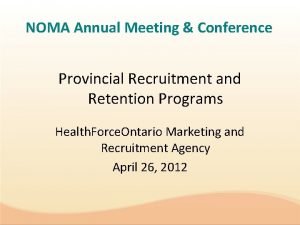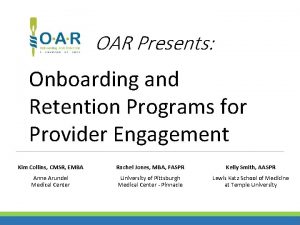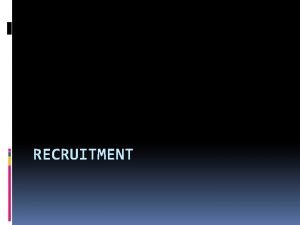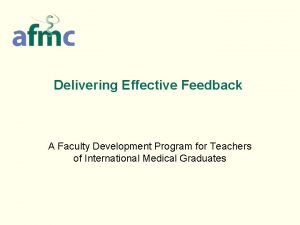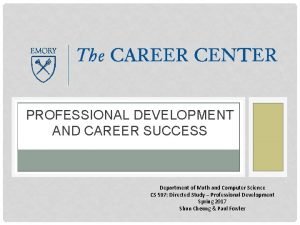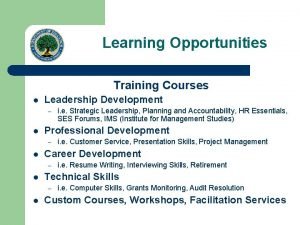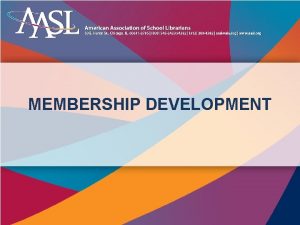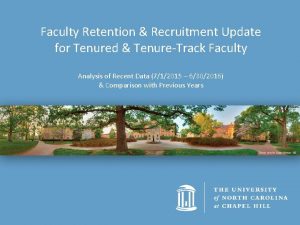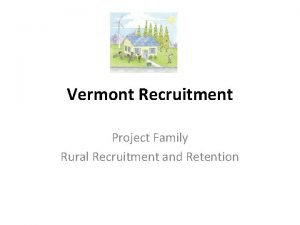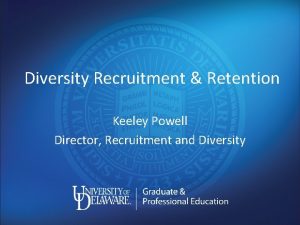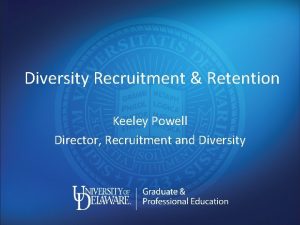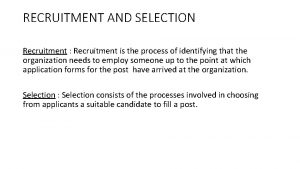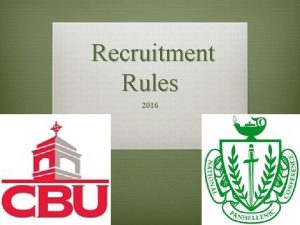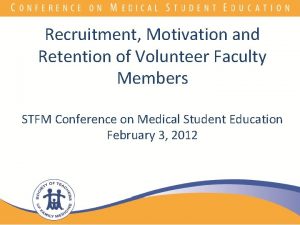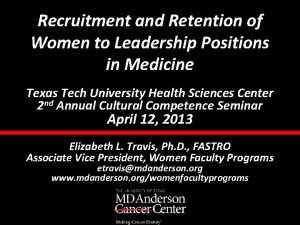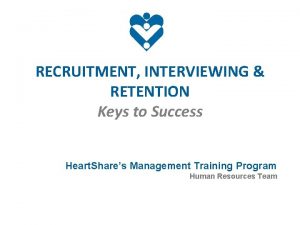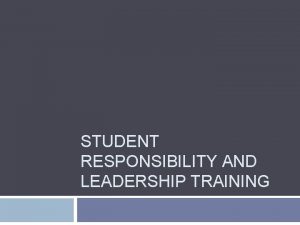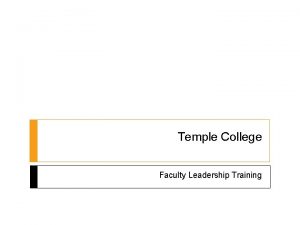Faculty Recruitment and Retention Leadership Development for Success






















. Nursing faculty shortage fact sheet. References • American Association of Colleges of Nursing [AACN](2017). Nursing faculty shortage fact sheet.](https://slidetodoc.com/presentation_image/ff8a23f64138ec13a44730eb1eae7369/image-23.jpg)

- Slides: 24

Faculty Recruitment and Retention Leadership Development for Success: Nursing and Health Sciences July 11, 2017 Anne Liners Brett Ph. D, RN

Session Description The US Department of Labor Statistics suggest that 34, 200 new faculty will be needed by 2022 to replace the 10, 200 current faculty who will retire, and 24, 000 new faculty positions will need to be added to meet enrollment demands. How will you recruit and retain quality faculty?

Session Objectives 1. Discuss the current status of the faculty shortage. 2. Identify strategies for recruitment and retention of faculty. 3. Discuss best practices based on empirical studies.

Current Status of Nursing Faculty • Average of nursing faculty based on NLN and AACN data • Doctorally prepared faculty 51. 5 years old (assistant professor) to 62. 2 years old (full professor) • Master’s prepared faculty average is 56. 6 years old with 16% greater than 60 years of age. (AACN, 2017; Cusson, 2014; NLN 2014) • Evans (2009) reports that currently half of all doctoral candidates are 45 -54 years of age. • AACN (2015) report a current nursing faculty vacancy of 6. 9% and up to 75% of current faculty could retire by 2019.

Frightening Statistics • 2016: 64, 067 potential baccalaureate and graduate nursing applicants were turned away in the United States (AACN, 2017). • 2018: Bureau of Labor Statistics predicts more than 581, 000 new RN positions will be created (AACN, 2010) • 2020: Foresee a deficit of more than 1, 000 nurses in US (Smith, 2009). Wisconsin alone predicts needing an addition 7, 500 new graduates in 2020 (Young, et al, 2016) • 2022: Bureau of Labor Statistics predicts 35% more nursing faculty will be needed to meet demand in addition 10, 200 faculty are expected to retire = total of 3, 420 new nursing faculty PER YEAR through 2022. (Mc. Menamin, 2014)

Perceptions of Faculty Role Employment in higher education in nursing is known for lower wages and high workloads with emphasis on outcomes, commitments to college wide activities/committees and engagement in scholarly activities for evidence based learning. (Clark, 2010)

Who are potential new faculty? • New graduates from MSN, DNP or Ph. D programs • Preceptors from clinical sites • Adjuncts moving to full time position • Faculty relocating geographically or across programs • NPs and DNPs deciding to move from practice to academia • Other

Attraction to Academia Findings from a qualitative study interviewing 15 nursing faculty suggest the following themes: • • • Wanting to teach Contributing to the profession Joy of seeing students learn Flexibility Intrinsic rewards Unattractive aspects: politics, salary and workload (Laurencelle, Scanlan & Brett, 2016)

Transition of Expert Clinician to Novice Academic Educator Anderson (2009) conducted a phenomenologic study interviewing 18 new nursing faculty from 14 programs exploring the work-role transition of clinical experts who transition into faculty roles. • Concerns raised by the participants included • Insufficient preparation for the role • Lack of understanding of the role itself • Insufficient socialization into the role

Expert Clinician to Novice Educator Metaphor of a mermaid swimming in a ‘sea of academia’ • Sitting on the shore – deciding to take the dive with uncertainty and fear of the unknown • Splashing in the shallows – lighter workload to get acclimated • Drowning – moving out of their comfort zone/learning and unlearning • Treading water – needing and soliciting feedback • Beginning strokes – finding balance; finding their stride; becoming part of the team • Throughout the water – integrating clinical expertise with teaching; striving for excellence. (Anderson, 2009)

Strategies for Recruitment • Word of mouth is most effective – “come join me at this great place” • Feedback from students – “my faculty really cared about me and helped me be successful” • Relationship with leader – “he/she is a great person to work with” • Reputation of the college/university • Outstanding salary and benefits

Recruitment opportunities • Identify successful adjuncts and encourage them to consider a faculty role. • Encourage students to consider continuing their education to earn credentials to become faculty • Become a learning site for students enrolled in MSN, DNP and Ph. D programs needing a practicum • Research opportunities for loan forgiveness etc. or for teaching such as the Wisconsin Initiative (Nurses for Wisconsin: Learn, Teach, Lead) • Visibility at nursing organizations and conferences

Retention is the Key Research suggests the keys to retention of nursing faculty include: • Leadership style of the nursing department head (Byrne & Martin, 2014) • Strong mentoring program to enculturate and support new faculty (Nowell, White, Mrklas & Norris, 2015) • Developing and sustaining a safe, healthy work environment (Brett, Branstetter & Wagner, 2014)

Leadership Style for Retention Findings from a quantitative study surveying 52 nurses across 4 Midwest states suggest: • Transformational leadership fosters trust, admiration and loyalty • Transactional leadership clearly delineates leader – follower roles with the goal of stimulating compliance with the bottom line • Significant positive relationship between transformational leadership and organizational commitment (potential for retention) • Significant negative relationship between transactional leadership and organizational commitment.

Leadership Style for Retention Study findings further implied: • Participants (76. 9%) perceived transactional leadership was the predominant style of their current department head. • The greater the faculty members perceived their department head to be a transactional leader the lower their professional satisfaction and organizational commitment. Recommendations: • Cultivate a culture of transformational leadership valuing faculty members and promoting shared governance. • Identify faculty professional satisfiers and dissatisfiers.

Mentoring for Retention Findings from a mixed method systematic review of mentoring in academia suggests: • New faculty are often unprepared to teach. • Mentoring can provide the support and resources to foster retention versus new faculty leaving academia due to frustration and confusion. • Mentoring can provide coaching to develop a skill set that includes: curriculum development, teaching strategies, assessment, classroom management skills, etc.

Why Mentoring Matters • Socialization into an academic environment • Academic culture and expectations • Prevalence of incivility within nursing education • The literature suggests that a nurse’s first exposure to horizontal violence frequently occurs in nursing school which has a devastating effect upon both the selfconfidence and self-image of the student. (King-Jones, 2011) • Based on their research Clark and Springer (2007) suggest 70% of the more than 500 respondents believed “that incivility in nursing education is a moderate to severe problem. ” (p. 8) • 10 Mean Games Faculty Play (Kathleen Heinrich, 2007) based on 1 minute writing exercise completed by 261 nurse educators attending the NLN Education Summit. • Lack of socialization into academia we teach the way we were taught. • Incivility may be unconscious and unintended.

Incivility vs. Mentoring Incivility • Culture of fear • Impairs learning • Destroys relationships • Poor communication • Impairs outcomes • Cause of attrition and turnover • Student/faculty dissatisfaction • Negative impact on public relations and/or marketing Mentoring • Culture of nurturing and support • Encourages problem solving and learning. • Builds relationships • Fosters communication • Facilitates positive outcomes • Facilitates retention • Student/faculty satisfaction • Marketing tool – what sets you apart from other programs.

Mentoring for Retention Guide new faculty along the novice to expert continuum • Opportunity to interfere with the incivility cycle • Opportunity to build collegial relationships • Provides support as the new faculty transitions from the clinical expert to educator • Investment upfront may result in faculty retention in the long term

Work Environment for Retention Recommendations from a quantitative study surveying 241 nursing faculty include: • Faculty satisfaction and retention is a significant role of academic leaders. • Understanding faculty perceptions and expectations are key to recruitment and retention. • Estimates suggest it costs 2. 5 times a faculty salary to replace an experienced faculty member. • Mentoring programs should be designed and implemented to focus on • Taking time for personal needs and growth. • Understanding thoroughly what situations mean to people. • Focusing on helping others to grow. • Create a culture of collaboration in decision making by analyzing the concept of shared governance.

Faculty Recruitment and Retention • No magic bullet to resolve the faculty shortage • Overarching evidence based recommendations: • Implement transformation leadership. • Effective relationship development. • Empowering faculty through shared governance enhances professional satisfaction. • Develop effective mentoring programs as a recruitment tool and retention strategy. • Advocate for changes in infrastructure such as salary, workloads, etc. recognizing that’s a long term goal.

Thanks!
. Nursing faculty shortage fact sheet.](https://slidetodoc.com/presentation_image/ff8a23f64138ec13a44730eb1eae7369/image-23.jpg)
References • American Association of Colleges of Nursing [AACN](2017). Nursing faculty shortage fact sheet. • AACN (2015). The impact of the economy on the nursing shortage. Retrieved from http: //www. aacn. nche. edu/Media/pdf/Economy. pdf. • Anderson, J. K. (2009). The work-role transition of expert clinician to novice academic educator. Journal of Nursing Education, 48(4), 203 -208. • Brett, A. L. , Branstetter, J. , & Wagner, P. (2014). Nurse educators’ perceptions of caring attributes in current and ideal work environments. Nursing Education Perspectives, 35(6), 360 -366. • Byrne, D. M. , & Martin, B. N. (2014). A solution to the shortage of nursing faculty: Awareness and understanding of the leadership style of the nursing department head. Nurse Educator, 39(3), 107 -112. • Clark, C. S. (2010). The nursing shortage as a community transformational opportunity: An Update. Advances in Nursing Science. 33(1), 35 -52. • Clark, C. & Springer, P. (2007). Thoughts on incivility: Student and faculty perceptions of uncivil behavior in nursing education. Nursing Education Perspectives, 28, 93 -97. • Clark, C. & Springer, p. (2007). Incivility in nursing education: A descriptive study of definitions and prevalence. Journal of Nursing Education, 46, 7 -14. • Cusson, R. M. (2014). Essay on how colleges can deal with shortages of nursing professors. Inside Higher Ed. Retrieved from https: //www. insidehighered. com/advice/2014/03/15/essay-how-collegescan-deal-shortages-nursing-professors • Feldman, H. R. , Greenberg, M. J. , Jaffe-Ruiz, M, Kaufman, S. R. and Cignarale, S. (2015). Hitting the nursing faculty shorage head on: Strategies to recruit, retain and develop nursing faculty. Journal of Professional Nursing, 31(3), 170 -178.

References • Heinrich, K. T. (2007). Joy stealing 10 mean games faculty play and how to stop the gaming. Nurse Educator, 32(1), 34 -38. • King-Jones, M. (2011). Horizontal violence and the socialization of new nurses, Creative Nursing, 17(2), 80 -86 • Laurencelle, F. Scanlan, J. & Brett, A. L. (2016). The Meaning of Being a Nurse Educator and Nurse Educators’ Attraction to Academia. Nurse Education Today, 39(4), 135 -140. • Mc. Menamin, P. (2014). 2022: Where have all the nurses gone? Georgia Nursing, 74(2), 8. • Nardi, D. A. & Gyurko, C. C. (2013). The global nursing faculty shortage: Status and solutions for change. Journal of Nursing Scholarship, 45(3), 317 -326. • National League for Nursing (2014). Faculty Shortage. Retrieved from http: //www. nln. org/advocacy-publicpolicy/issues/faculty-shortage • Nowell, L. , White, D. E, Mrklas, K. , & Norris, J. M. (2015). Mentorship in nursing academia: A systematic review protocol. Systematic Reviews, 4(16). • Roughton, S. (2013). Nurse faculty characteristics and perceptions predicting intent to leave. Nurse Education Perspectives, 34(4), 217 -225. • Smith, C. A. , (2009). Nursing workforce planning: The key to success. Healthcare Quarterly, 12(2), 78 -85. • Young, L, K. , Adams, J. L. , Lundeen, S. , May D. A. , Smith, R. and Wendt, L. E. (2016). Nurses for Wisconsin: A collaborative initiative to enhance the nurse educator workforce. Journal of Professional Nursing, 32(4), 292299.
 Edcdp
Edcdp Building a recruitment and retention plan
Building a recruitment and retention plan Physician recruitment onboarding and retention
Physician recruitment onboarding and retention What works student retention and success
What works student retention and success Meaning of recruitment
Meaning of recruitment Recruitment retention recovery
Recruitment retention recovery Vibrant faculty recruitment
Vibrant faculty recruitment Your child's success or lack of success
Your child's success or lack of success Your child's success or lack of success
Your child's success or lack of success Ge aviation female diversity recruitment leadership summit
Ge aviation female diversity recruitment leadership summit Fulbright faculty development program
Fulbright faculty development program Feedback for faculty development programme
Feedback for faculty development programme Transactional leadership vs transformational leadership
Transactional leadership vs transformational leadership Adaptive leadership style
Adaptive leadership style Situational leadership vs adaptive leadership
Situational leadership vs adaptive leadership Formulas for career success: portfolio development
Formulas for career success: portfolio development Leadership learning and development
Leadership learning and development Iso 22301 utbildning
Iso 22301 utbildning Novell typiska drag
Novell typiska drag Nationell inriktning för artificiell intelligens
Nationell inriktning för artificiell intelligens Returpilarna
Returpilarna Varför kallas perioden 1918-1939 för mellankrigstiden
Varför kallas perioden 1918-1939 för mellankrigstiden En lathund för arbete med kontinuitetshantering
En lathund för arbete med kontinuitetshantering Adressändring ideell förening
Adressändring ideell förening Vilotidsbok
Vilotidsbok
